Strawberry IPM Newsletter No. 2 – May 27, 2021
Strawberry IPM Newsletter No. 2 – May 27, 2021
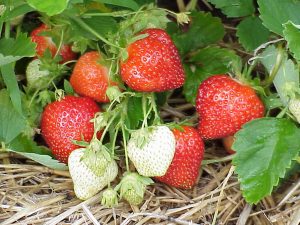
Click on photos to enlarge
WARMER WEATHER PUSHES STRAWBERRIES & PESTS
Tarnished Plant Bug & Strawberry Bud Weevil Numbers Higher in Some Fields.
Twilight Meeting June 9, 2021, at 6 pm, Jordan’s Farm (Cape Elizabeth)
Situation:
Some warmer weather has kept strawberry fields advancing at a rapid pace. Southern fields that had rowcovers this spring are starting to show a few red fruits, while later, straw-mulched fields are coming into bloom. In general, the fields I have visited look very good and the crop potential is high. There is still some risk of frost in the week ahead, so growers should remain vigilant about night temperatures in their fields. Pest numbers have started to rise this week, and early bloom to petal fall is a critical time for monitoring the pest situation in your field.
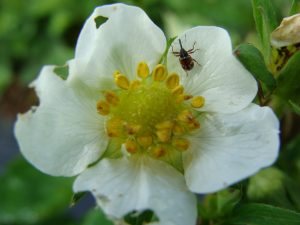
Strawberry bud weevil: There was an increase in clipper activity this week, but most fields were under the spray threshold of 1.2 clipped buds per two feet of row. Fields that are in the late bloom stage and beyond are no longer susceptible to clipper damage, so attention should be focused on fields that are just starting to show blossoms. Small holes in the petals of opening flowers indicate clipper feeding activity. Affected flower buds are clipped below the base and dangle from their stems looking wilted and brown. Clippers are now moving on to the buds of raspberries and blackberries, although they do not usually cause significant injury.
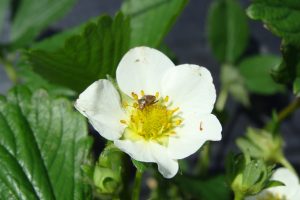
Tarnished plant bug activity has also been increasing this week, with more very small, first instar nymphs being found among the flower clusters. Only one field was over the spray threshold of 4 or more flower clusters infested per 30 sampled, but nymphs were found in most fields and numbers are expected to rise if we continue to see warmer, dry weather. The nymphs are very small (2 mm), active, yellow-green insects. You should scout for nymphs in any field with open flowers now. Insecticide options for tarnished plant bugs include malathion, Assail®, Brigade®, Bifenture®, Dibrom®, Danitol®, and PyGanic®.
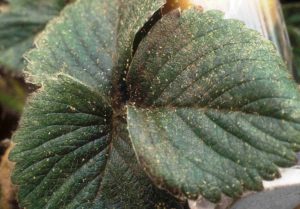
Two-spotted spider mites were found in almost every field visited this week, but mostly well below the spray threshold of 25% of leaves infested, and many predator mites were also observed, which may provide some natural control. However, warm, dry conditions can allow mite populations to build rapidly, so regular monitoring should be carried out. Chemical control options for two-spotted spider mites include Acramite®, Portal®, Nealta® Savey®, Zeal®, Vendex®, Oberon®, Brigade®, Danitol® and JMS Stylet Oil® (oils will cause plant injury if used in combination with captan or within 14 days of an application of sulfur).

Diseases: Fields in bloom need to be protected from infection with gray mold caused by the fungus Botrytis cinerea, especially when conditions have been damp. First fungicide applications should be made when blossoms begin to open (~5% bloom), a second spray is recommended at about full bloom, and a third at petal fall. The third spray may be held back if conditions have remained dry since the full bloom application. If there are wet conditions, such as more than one inch of rain, between applications, an additional application should be considered.
Fungicide choices for control of gray mold in strawberries include: Topsin M® + captan, Elevate®, Captevate®, Switch®, Scala® and Pristine®. Remember to alternate fungicides with different modes of action for resistance management purposes.
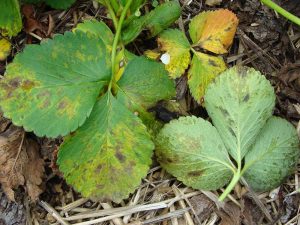
Angular leaf spot has been observed in a couple of fields this week, but not in high amounts. This is a bacterial disease that is characterized by translucent leaf spots that may turn yellow and eventually black. The symptoms tend to start on the lower leaves but may move upwards as bacterial spores are splashed up by rain or irrigation water. Infection of the calyxes results in black berry stems and caps, reducing their marketability. Bacterial angular leaf spot is favored by cool, wet weather. Frequent irrigation for frost protection can encourage it’s development and spread. While copper sprays can reduce the spread of the disease, application of copper sprays after bloom can result in fruit injury and is not recommended. Hydrogen dioxide (OxiDate®) may also have some activity against angular leaf spot when used on strawberries as part of a gray mold management program.
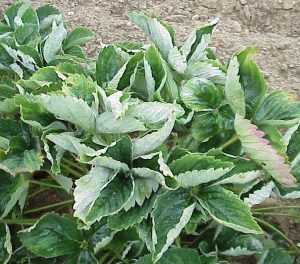
Powdery mildew: I’ve observed early indications of powdery mildew in several fields this week. Look for upward cupping of the leaves and reddish streaking or lesions on the leaf and flower stems. Powdery mildew can reduce the vigor of the plants and cause the fruit to become hard and dry. Consider using a fungicide that will control powdery mildew, such as captan + Topsin-MÒ, or PristineÒ, in addition to gray mold when making bloom spray applications. Other materials with good effectiveness on powdery mildew include: OrbitÒ, RallyÒ, TorinoÒ FontelisÒ, ProcureÒ and Luna Sensation®,.
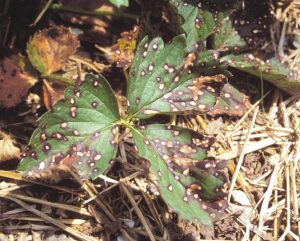
Leaf spot is a fungal disease characterized by small purple spots with white centers on the leaves. The symptoms are often first visible on the older, lower leaves. I’ve seen some leaf spot in fields scouted this spring. If you see leaf spot in your field, you should consider using a fungicide that will provide control as part of your spray program for gray mold. Products such as Captan®, Luna Sensation®, Mervion® and Pristine® have activity on both diseases.
Leather rot (Phytopthora cactorum) can become a problem in fields where standing water is common during bloom and fruit development, especially if the fields were not mulched last fall. Incidence of leather rot can be reduced by applying straw mulch between the rows to prevent berries from touching the soil and reducing soil splashing onto the berries. Foliar sprays of Aliette®, Prophyt® or Phostrol® may be applied during bloom and fruit development to prevent leather rot.
Deer: Feeding damage by deer has been observed in several fields this spring. Rows of plants look weak or dead and have few, if any leaves, although the root system may look healthy. When deer feed on plants during the winter the plants often die, as they are exposed and the crowns are damaged. By the time the mulch is removed, the plants will just look dead, and any evidence left by the deer has been washed away. Deer will also feed in the spring, eating leaves and sometimes damaging crowns. If deer are a problem in your area, it is best to fence in the planting area before they start feeding in it. Temporary electric fences are usually adequate if set up correctly and in a timely manner. Always contact your local game warden before you consider dispatching any offending animals.
Spring Growers’ Twilight Meeting
The Maine Vegetable & Small Fruit Growers Association will be having a Spring Twilight Meeting on Wednesday, June 9 at 6 pm at Jordan Farm, 21 Wells Road, Cape Elizabeth. We will have the usual strawberry update and a discussion of how things went last year for pick-your-own operations under the COVID restrictions. In addition, there will be a tour of Jordan Farm’s new pesticide storage building that was built with an NRCS grant, a discussion of the current labor situation, and a talk about interseeding cover crops by Cumberland County Extension agent Jason Lilley. Hope to see you there!
2021-2022 New England Small Fruit Management Guides The latest edition of the Guide will soon be available online
Sincerely,
David T. Handley
Vegetable and Small Fruit Specialist
Highmoor Farm Pest Management Unit
P.O. Box 179 17 Godfrey Dr.
Monmouth, ME 04259 Orono, ME 04473
207.933.2100 1.800.287.0279
Where brand names or company names are used, it is for the reader’s information. No endorsement is implied nor is any discrimination intended against products with similar ingredients. Always consult product labels for rates, application instructions and safety precautions. Users of these producers assume all associated risks.
The University of Maine is an equal opportunity/affirmative action institution.
